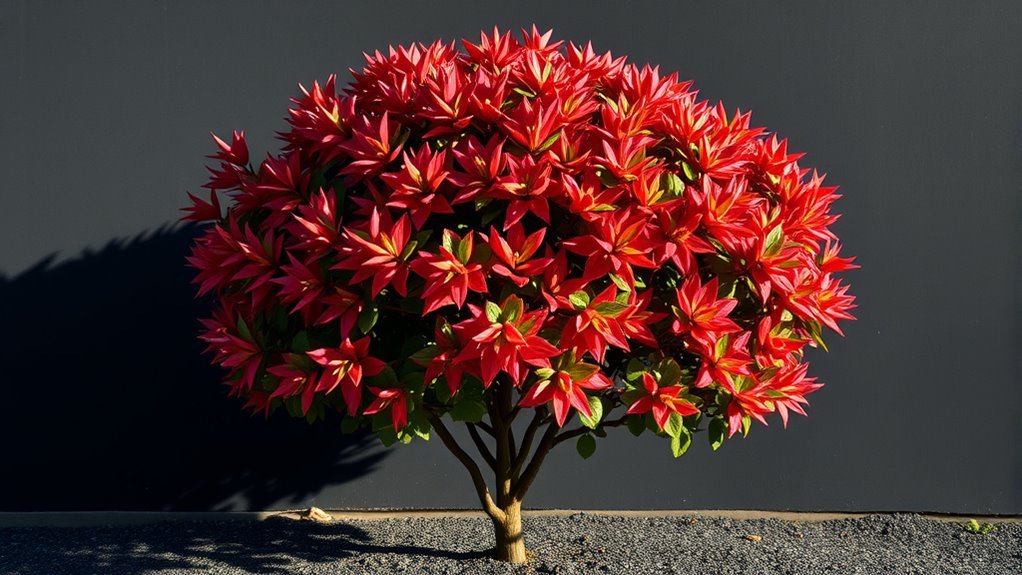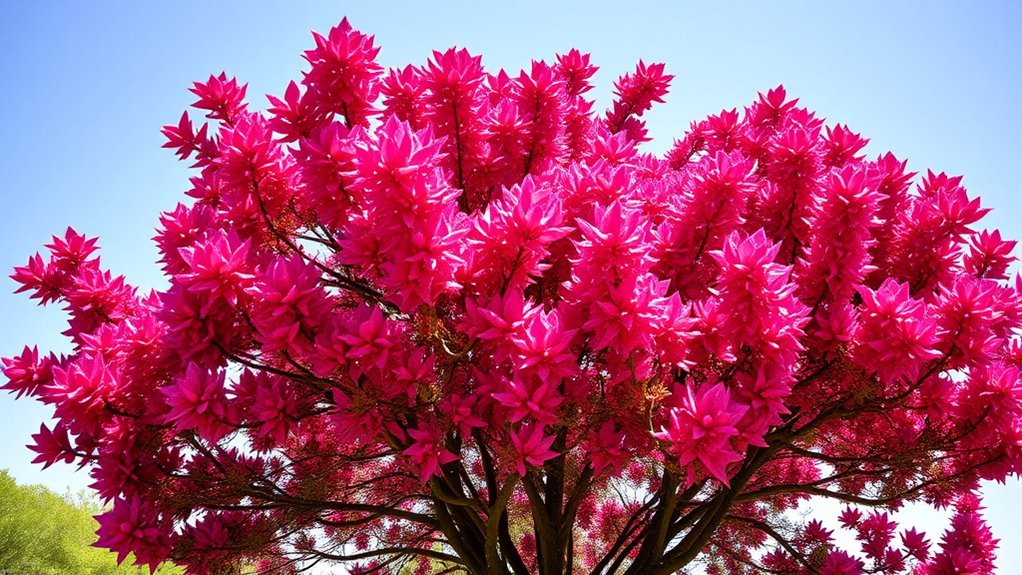The Dwarf Eastern Redbud reaches a compact height of 3 to 5 feet and a width of 4 to 6 feet, making it ideal for smaller spaces. In contrast, the Texas Redbud grows considerably larger, attaining heights of 10 to 20 feet and widths of 20 to 30 feet, creating a striking visual impact in gardens and parks. Understanding these size differences is essential for selecting the right tree for landscaping needs, and more details await exploration.
Main Points
- The Dwarf Eastern Redbud typically grows to a height of 3 to 5 feet, making it suitable for smaller spaces.
- In contrast, the Texas Redbud grows significantly taller, reaching heights between 10 to 20 feet.
- The Dwarf Eastern Redbud has a width of 4 to 6 feet, while the Texas Redbud can spread 20 to 30 feet wide.
- The Dwarf variant exhibits a moderate growth rate, achieving 12 to 15 inches per year, compared to the Texas Redbud's vigorous growth.
- Understanding these size differences is crucial for making informed landscaping decisions based on available space.
Overview of Dwarf Eastern Redbud
The Dwarf Eastern Redbud, a compact variant of the well-known Eastern Redbud, is prized for its ornamental value and manageable size. Typically reaching heights of 3 to 5 feet, it displays a bushy form that makes it suitable for smaller gardens or urban environments.
Its heart-shaped leaves emerge in spring, providing a lush green backdrop to its stunning pink flowers, which bloom in early spring, attracting pollinators such as bees and butterflies.
The Dwarf Eastern Redbud is known for its flexibility to various soil types and its resilience to drought once established. This tree thrives in full sun to partial shade, making it versatile for different planting conditions.
Its striking color and compact nature not only improve garden aesthetics but also serve as a focal point in gardening projects.
Altogether, the Dwarf Eastern Redbud is an excellent choice for those seeking beauty and practicality in a manageable tree size.
Overview of Texas Redbud

While often confused with its Dwarf counterpart, the Texas Redbud stands out for its larger size and striking presence in scenery. This deciduous tree, scientifically known as Cercis canadensis var. texensis, is native to Texas and parts of Oklahoma, thriving in a variety of soil types.
Its heart-shaped leaves emerge in spring, creating a lush green canopy, and its stunning pink to purple flowers bloom before the foliage, offering a fascinating display.
Texas Redbuds can serve as focal points in environments, attracting attention with their vibrant colors. They are also known for their flexibility, often flourishing in both urban and rural settings.
This species supports local wildlife, providing food and habitat for various birds and pollinators. With proper care, the Texas Redbud can live for many years, making it a cherished addition to gardens and parks alike.
Size Comparison: Height and Width
When comparing the Dwarf Eastern Redbud to the Texas Redbud, notable differences in height and width emerge.
The Dwarf Eastern Redbud typically reaches a more compact height, while the Texas Redbud can grow taller and broader.
Understanding these size distinctions is essential for selecting the right tree for specific landscaping needs.
Dwarf Eastern Redbud Height
Dwarf Eastern Redbuds typically reach a height of 3 to 5 feet, making them an ideal choice for smaller settings or gardens. Their compact stature allows them to fit seamlessly into various environments, whether as a focal point or part of a mixed planting scheme.
In addition to their height, these trees typically spread to about 4 to 6 feet wide, creating a rounded canopy that provides ample shade. Their smaller size also improves their accessibility, allowing gardeners to maintain them with ease.
The Dwarf Eastern Redbud's striking pink to purple flowers in early spring further highlight its appeal, offering vibrant color without overwhelming the space. This combination of height and beauty makes them a favored selection among garden designers and homeowners alike.
Texas Redbud Height Comparison
The Texas Redbud, known for its larger size compared to the Dwarf Eastern Redbud, typically grows to a height of 10 to 20 feet. This considerable height makes it a prominent feature in many settings.
In contrast, the Dwarf Eastern Redbud generally reaches only 3 to 5 feet, creating a notable distinction in vertical presence.
The Texas Redbud's impressive stature allows it to serve as an effective focal point in gardens and parks, attracting attention during its vibrant spring bloom.
The height range of the Texas Redbud also makes it suitable for various planting scenarios, from residential yards to larger commercial spaces.
Its ability to provide shade and structure further improves its appeal in design.
Width Differences Explained
Size is not only determined by height but also by width, which plays an essential role in the general appearance of both the Texas Redbud and the Dwarf Eastern Redbud.
The Texas Redbud typically exhibits a broader canopy, reaching an average width of 20 to 30 feet when mature. This expansive growth allows it to create a more notable visual impact in larger environments.
In contrast, the Dwarf Eastern Redbud maintains a more compact profile, usually spanning 8 to 12 feet in width. This makes it an ideal choice for smaller gardens or tighter spaces, where its size can be appreciated without overwhelming the surroundings.
Understanding these width differences aids gardeners in selecting the right tree for their specific gardening needs.
Growth Rate of Dwarf Eastern Redbud

Notable for its compact stature, the Dwarf Eastern Redbud typically exhibits a moderate growth rate that makes it an appealing choice for smaller settings.
Generally, this tree can achieve a height of 3 to 4 feet and a width of about 4 to 5 feet within a few years. Its growth rate averages approximately 12 to 15 inches per year, allowing it to establish itself without overwhelming limited spaces.
The Dwarf Eastern Redbud also benefits from versatility to various soil types, provided they are well-drained. This versatility further supports its growth, as it can thrive in diverse environments.
Additionally, the tree's early spring blossoms add aesthetic value while its moderate growth allows for easier maintenance.
Altogether, the Dwarf Eastern Redbud presents an excellent option for gardeners seeking a visually appealing, manageable tree that improves smaller settings.
Growth Rate of Texas Redbud

Distinguished by its larger stature compared to the Dwarf Eastern Redbud, the Texas Redbud showcases a more vigorous growth rate. This characteristic makes it an attractive option for those seeking a faster-growing ornamental tree. On average, the Texas Redbud can grow between 10 to 20 feet in height, reaching maturity more quickly than its dwarf counterpart.
Several factors contribute to its impressive growth:
- Climate Flexibility: The Texas Redbud thrives in a range of climates, allowing for consistent growth across various regions.
- Soil Preference: It prefers well-drained soils, which supports robust root development and nutrient uptake.
- Sunlight Exposure: Full to partial sunlight encourages faster growth, as the tree effectively utilizes photosynthesis.
Ideal Growing Conditions for Dwarf Eastern Redbud
While the Dwarf Eastern Redbud is often appreciated for its compact stature, it thrives best under specific growing conditions that boost its health and vibrancy. This tree prefers well-drained soil, ideally rich in organic matter, which supports its root development.
A location that receives full sun to partial shade improves its blooming potential, as these trees typically require at least six hours of sunlight daily.
The Dwarf Eastern Redbud is also tolerant of various soil types, including clay and sandy soils, but it flourishes in slightly acidic to neutral pH levels.
Regular watering during dry spells is essential to maintain its vigor, particularly in the first few years after planting.
Mulching around the base aids in moisture retention and suppresses weeds.
Ideal Growing Conditions for Texas Redbud
The Texas Redbud, known for its striking spring blossoms, flourishes in a variety of growing conditions that boost its resilience and beauty.
This native tree prefers well-drained soils and can modify to various soil types, including sandy and clay soils. Adequate sunlight also plays an important role in its growth, making it ideal for areas that receive full sun to partial shade.
Key ideal growing conditions include:
- Soil: Well-drained, loamy soil is preferred, but the Texas Redbud can tolerate clay and sandy conditions.
- Sunlight: Full sun exposure (at least 6 hours daily) improves flowering and overall health, though it can tolerate partial shade.
- Watering: Regular watering during dry spells is essential, especially in the establishment phase, to encourage deep root growth.
Common Questions
Can Dwarf Eastern Redbuds Be Grown in Containers?
Dwarf Eastern Redbuds can indeed be grown in containers. Their compact size makes them suitable for pots, allowing gardeners to enjoy their vibrant blooms and attractive foliage in smaller spaces while ensuring proper care and drainage.
Do Texas Redbuds Attract Wildlife Like Birds and Butterflies?
Texas redbuds are known to attract various wildlife, including birds and butterflies. Their beautiful flowers provide essential nectar and seeds, making them a favored choice for gardeners looking to improve local biodiversity and support pollinator populations.
What Is the Lifespan of Dwarf Eastern Redbuds?
The lifespan of Dwarf Eastern Redbuds typically ranges from 20 to 30 years. Factors such as environmental conditions, care, and disease resistance can influence their longevity, impacting their general health and growth throughout their life cycle.
Are There Any Pests Specific to Texas Redbuds?
Texas redbuds may encounter pests such as aphids, scale insects, and spider mites. These pests can affect the tree's health and aesthetics, making monitoring and management essential for maintaining vibrant foliage and general well-being.
How Do I Prune a Dwarf Eastern Redbud?
To prune a dwarf eastern redbud, one should remove dead or crossing branches in early spring, shaping the tree while maintaining its natural form. Proper tools and techniques guarantee a healthy, attractive growth for the plant.

